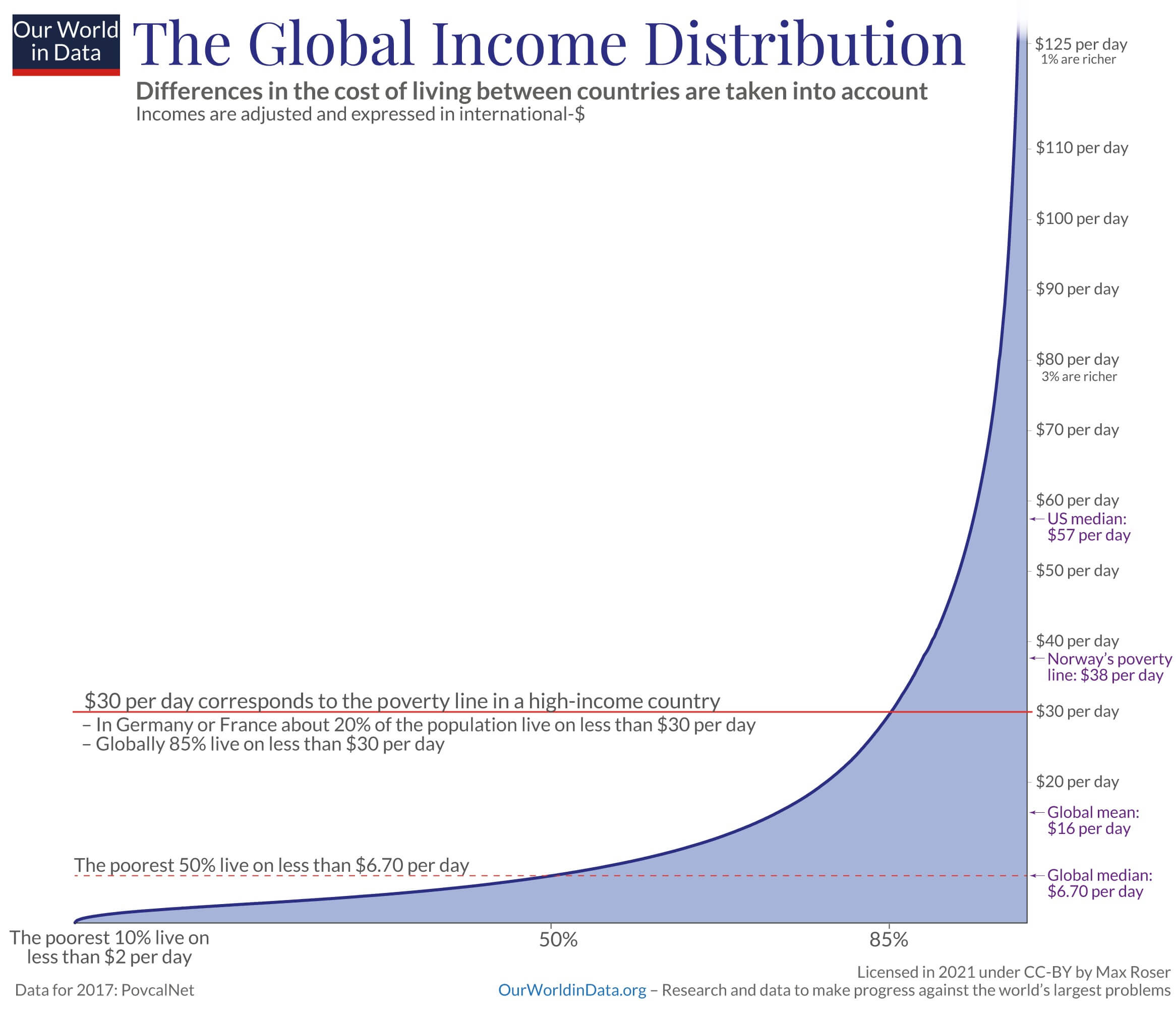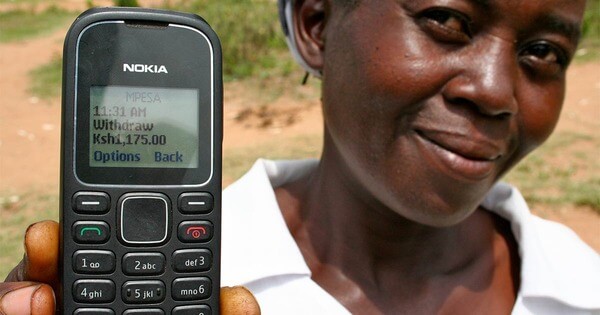We believe global health and development is robustly important, tractable, and neglected. As a result, global health and development can be a highly promising cause area to work on — if you’re a good fit.
Read on to find out how we reached this conclusion.
What is global health and development?
Global health and development is all about improving the wellbeing of people across the world through treating and preventing disease, helping people out of poverty, and saving lives. Although there’s suffering and ill-health in every country, there’s a huge amount of inequality in how poverty and disease are concentrated across the world – and they tend to be the most severe in low- and middle-income countries.
If you’re reading this from a high-income country, for example, you’re likely among the top 5% wealthiest people in the world. In fact, many readers will have an income 10 times greater than the average (or if we’re being technical, median) person on the planet.
This graph from Our World in Data shows the extent of global income inequality.

Due to this vast economic inequality, you can save a person’s life with a sum you wouldn’t even notice if it went missing. And perhaps more importantly, regardless of your current income level, you can use your career to do much more than save a single person’s life, particularly if you focus on the world’s poorest regions.
How important is global health and development?
Despite impressive progress in recent decades, much of the world’s population remains very poor, with around one in ten living on less than $1.90 a day – the threshold for extreme poverty. This is even worse than it might sound: it’s adjusted for how much $1.90 would buy you in the United States, rather than in low- and middle income countries where most of the global poor live.
On top of this, more than 200 million years of healthy life are lost every year to diseases that we already know how to effectively treat, such as malaria, tuberculosis, and neglected tropical diseases, but which are still too costly for low-income countries to combat.
One example of such an opportunity is combating malaria. Every year more than half a million people (most of them children) die of malaria. At the same time, treating even complicated cases of malaria costs around $30 and preventing them costs significantly less. High-income countries have had no trouble eradicating malaria, but these costs are still too high in the poorest parts of the world.
Another example is lead exposure. One in every three children globally is affected by lead poisoning, which hinders brain development and increases antisocial behavior. In high-income countries, regulation has all but eliminated high lead concentrations from sources like fuel and paint. However, in many low- and middle-income countries, dangerous lead concentrations are still commonplace.
There’s significant evidence that the scope for improvement from an economic perspective is enormous too. The average income in low- and middle-income countries is around $14 a day. This is far below the large wage increases achieved in recent centuries by most countries via better government policies, management, and technology.
Overall, the size of these problems, particularly in low- and middle-income countries, makes global health and development a really important cause area. However, the scale might not be quite as large as other important cause areas, like animal welfare and global catastrophic risks.
This map from Our World in Data shows just how unequally distributed disease is across the world.
How tractable is global health and development as a cause area?
Significant improvements to global health and development are surprisingly tractable. Let’s start with looking at humanity’s progress in the past. Within 30 years, we’ve reduced extreme poverty from affecting more than a third of humanity to less than 10%. And in the past 50 years, global life expectancy has increased by 30%, with most of this change occurring due to improvements to health in low- and middle-income countries.
There’s a wealth of proven, cost-effective interventions that help improve people’s health and economic opportunities. Global health charity evaluator GiveWell has identified several. This includes the Against Malaria Foundation, which prevents a child from contracting malaria for every $7 you donate to it; the Schistosomiasis Control Initiative, which on average provides a child with 25% higher income throughout their lives for every $10 you donate to it; and GiveDirectly, which transfers money to those living in extreme poverty to use how they’d like. Dozens of trials have shown that recipients generally put this to great use, funding smart investments in their own health, wellbeing, and equipment for work.

The above examples also illustrate that global health and development is among the cause areas with the strongest evidential support. This field is quite unprecedented in how many of its tools and opportunities can be (and have been) studied extensively, which significantly increases our confidence in its tractability. However, there are still plenty of opportunities for identifying new interventions (and in some cases starting new organizations) that are less certain but may turn out to be even more effective than those we have today.
How neglected is global health and development?
Global health and development is quite neglected relative to many popular causes, but less neglected than some of our other top cause areas. Governmental and philanthropic spending on health and development in low- and middle-income countries sums up to around $200 billion. This may sound like a lot, but it’s actually less than half of the total assets of the Italian post company alone.
Most donors (and volunteers, etc.) prefer to help those closer to them, leading to only 6% of donations going to international charities. Since the vast majority of wealthy donors live in high-income countries, most of that money stays at home. This means rich countries (and cities, and neighborhoods) have vastly more resources than poorer ones. For example, the country of Niger loses 750 times more healthy years of life to disease than Silicon Valley every year, yet Silicon Valley residents receive about 5 times as many donations for health-related causes. This means that someone in Silicon Valley would receive more than 3,500 times more donations for every year of healthy life lost relative to someone in Niger.
Why might you not want to prioritize global health and development?
Many people believe that charity starts at home. As a result, they may prefer to help out in their own neighborhood or country. Whether you think you should donate locally or abroad depends on a host of ethical questions (for example, if you give more weight to utilitarian considerations or reciprocity). There’s a wide range of legitimate moral views, and it’s tricky to decide which one is ultimately right.
However, if you just want to maximize your impact regardless of who benefits, then it becomes a relatively easy empirical question about where you can do the most good. Regardless of where you are physically, you can often have 100x or more impact in low- and middle-income countries than in high-income countries. This is because in richer countries, governmental agencies often already provide the basic services people need for a majority of the population, like education and significant medical care.
Another reason you might want to prioritize other cause areas over global health and development is if you want to direct your efforts to help non-human animals. Because of the sheer number of animals bred as livestock, there are likely even more cost-effective things you could do for animals if you think they’re worth helping. Once again, this issue depends on your own values — check out our cause area profile on animal welfare (coming soon) to learn more.
Another common reason people end up prioritizing other cause areas is because they prefer work that has the potential to be far more impactful – even if that outcome is not as certain or robust as the opportunities in global health and development. If you take an expected value approach, you might prefer such high-risk high-reward opportunities. One promising example of this approach is preventing global catastrophic risks — such as nuclear war, pandemics, and extreme climate change.
What can you do in global health and development?
The majority of people can contribute far more to their top cause areas using their career than they can with donations, advocacy or volunteering alone. There are a number of promising career paths if you want to have an impact in global health and development – a good place to start is our career profiles on Development Economics, Nonprofit Entrepreneurship, and Civil Service in Low and Middle Income Countries. However, there are many more career paths that can have a significant impact in global health and development, and we’re working on multiple future career profiles in this space.
In addition to using your career, global health and development is a cause area where donations can do a lot of good. This is because there are many proven interventions that are incredibly effective, but need a lot of funding to scale and reach the size of the problem.
A great source for donation recommendations in global health and development is GiveWell – arguably the world’s top charity evaluator. Many of the charities they recommend can, on average, provide people with a full healthy year of life for every $100 you donate (or provide similarly impressive results in increasing education, lifting families out of poverty, and more). And one great way to generate large amounts of donations for your favorite cause is by Earning to Give.
Additional resources
Recommended resources for taking action
Fellowships and internships
Here are a few great recurring opportunities for those who are interested in global health and development, and are early-career or still studying:
- The United Nations Development Programme, World Health Organization, and the World Food Programme both regularly offer internships, and are available in a wide range of locations.
- The World Bank’s Young Professionals Program is a prestigious multi-year program that serves as an entry point into development careers within a large multilateral organization.
- The Sabin Vaccine Institute runs an internship program for undergraduate and postgraduate students.
Online courses
These are courses that have been recommended to us by experts, or look like particularly good ways to upskill within global health:
- J-PAL, a leading evaluation and research organization, has collaborated on an impressive number of courses you can find here. They focus on development policy design, implementation, and evaluation.
- This free course run by the University of Copenhagen offers an introduction to key ideas in global health.

